Variations in the Simulation of Climate Change Impact Indices due to Different Land Surface Schemes over the Mediterranean, Middle East and Northern Africa
Abstract
:1. Introduction
2. Data and Indices
2.1. Description of Simulations
2.2. Impact Indices
3. Results
3.1. Radiative Index of Dryness
3.2. Fuel Dryness Index (Fd)
3.3. Water-Limited Yield (Yw)
4. Summary and Conclusions
Supplementary Materials
Author Contributions
Funding
Acknowledgments
Conflicts of Interest
References
- Lelieveld, J.; Hadjinicolaou, P.; Kostopoulou, E.; Chenoweth, J.; El Maayar, M.; Giannakopoulos, C.; Hannides, C.; Lange, M.A.; Tanarhte, M.; Tyrlis, E.; et al. Climate change and impacts in the eastern Mediterranean and the Middle East. Clim. Chang. 2012, 114, 667–687. [Google Scholar] [CrossRef] [PubMed]
- Zittis, G.; Hadjinicolaou, P.; Fnais, M.; Lelieveld, J. Projected changes in heat wave characteristics in the eastern Mediterranean and the Middle East. Reg. Environ. Chang. 2016, 16, 1863–1876. [Google Scholar] [CrossRef]
- Lelieveld, J.; Proestos, Y.; Hadjinicolaou, P.; Tanarhte, M.; Tyrlis, E.; Zittis, G. Strongly increasing heat extremes in the Middle East and North Africa (MENA) in the 21st century. Clim. Chang. 2016, 137, 245–260. [Google Scholar] [CrossRef] [Green Version]
- Constantinidou, K.; Hadjinicolaou, P.; Zittis, G.; Lelieveld, J. Effects of climate change on the yield of winter wheat in the eastern Mediterranean and Middle East. Clim. Res. 2016, 69, 129–141. [Google Scholar] [CrossRef]
- Giorgi, F.; Gutowski, W.J., Jr. Regional dynamical downscaling and the CORDEX initiative. Annu. Rev. Environ. Resour. 2015, 40, 467–490. [Google Scholar] [CrossRef]
- Laprise, R. Regional climate modeling. J. Comput. Phys. 2008, 227, 3641–3666. [Google Scholar] [CrossRef]
- Rummukainen, M. State-of-the-art with regional climate models. Wiley Interdiscip. Rev. Clim. Chang. 2010, 1, 82–96. [Google Scholar] [CrossRef]
- Betts, A.K. Land-Surface-Atmosphere Coupling in Observations and Models. J. Adv. Model. Earth Syst. 2009, 1, 4. [Google Scholar] [CrossRef]
- Seneviratne, S.I.; Stöckli, R. The Role of Land–Atmosphere Interactions for Climate Variability in Europe. In Climate Variability and Extremes during the Past 100 Years; Brönnimann, S., Luterbacher, J., Ewen, T., Diaz, H., Stolarski, R., Neu, U., Eds.; Springer: Dordrecht, The Netherlands, 2008. [Google Scholar]
- Seneviratne, S.I.; Corti, T.; Davin, E.L.; Hirschi, M.; Jaeger, E.B.; Lehner, I.; Orlowsky, B.; Teuling, A.J. Investigating soil moisture-climate interactions in a changing climate: A review. Earth-Sci. Rev. 2010, 99, 125–161. [Google Scholar] [CrossRef]
- Cheng, W.; Moore, J.C.; Cao, L.; Ji, D.; Zhao, L. Simulated climate effects of desert irrigation geoengineering. Sci. Rep. 2017, 7, 46443. [Google Scholar] [CrossRef] [Green Version]
- Lin, Y.; Dong, W.; Zhang, M.; Xie, Y.; Xue, W.; Huang, J.; Luo, Y. Causes of model dry and warm bias over central U.S. and impact on climate projections. Nat. Commun. 2017, 8, 881. [Google Scholar] [CrossRef] [PubMed] [Green Version]
- Sippel, S.; Zscheischler, J.; Mahecha, M.D.; Orth, R.; Reichstein, M.; Vogel, M.; Seneviratne, S.I. Refining multi-model projections of temperature extremes by evaluation against land–atmosphere coupling diagnostics. Earth Syst. Dyn. 2017, 8, 387–403. [Google Scholar] [CrossRef]
- Davin, E.L.; Maisonnave, E.; Seneviratne, S.I. Is land surface processes representation a possible weak link in current Regional Climate Models? Environ. Res. Lett. 2016, 11, 074027. [Google Scholar] [CrossRef] [Green Version]
- Tanarhte, M.; Hadjinicolaou, P.; Lelieveld, J. Intercomparison of temperature and precipitation data sets based on observations in the Mediterranean and the Middle East. J. Geophys. Res. 2012, 117, D12102. [Google Scholar] [CrossRef]
- Zittis, G. Observed rainfall trends and precipitation uncertainty in the vicinity of the Mediterranean, Middle East and North Africa. Theor. Appl. Climatol. 2017. [Google Scholar] [CrossRef]
- Giorgi, F.; Jones, C.; Asrar, G.R. Addressing climate information needs at the regional level? The CORDEX Framework. WMO Bull. 2009, 58, 175–183. [Google Scholar]
- Stéfanon, M.; Martin-StPaul, N.K.; Leadley, P.; Bastin, S.; Dell’Aquila, A.; Drobinski, P.; Gallardo, C. Testing climate models using an impact model: What are the advantages? Clim. Chang. 2015, 131, 649–661. [Google Scholar] [CrossRef]
- Budyko, M.I. Chapter VI: Climatic factors of geographic zonality. Geophys. J. Int. 1974, 18, 317–370. [Google Scholar]
- Snyder, R.L.; Spano, D.; Duce, P.; Baldocchi, D.; Xu, L. A fuel dryness index for grassland fire-danger assessment. Agric. For. Meteorol. 2006, 139, 1–11. [Google Scholar] [CrossRef]
- Zittis, G.; Hadjinicolaou, P.; Lelieveld, J. Comparison of WRF physics parameterizations over the MENA-CORDEX domain. Am. J. Clim. Chang. 2014, 3, 490–511. [Google Scholar] [CrossRef]
- Zittis, G.; Hadjinicolaou, P. The effect of radiation parametererization schemes on surface temperature in regional climate simulations over the MENA-CORDEX domain. Int. J. Climatol. 2017, 37, 3847–3862. [Google Scholar] [CrossRef]
- Tewari, M.; Chen, F.; Wang, W.; Dudhia, J.; LeMone, M.A.; Mitchell, K.; Ek, M.; Gayno, G.; Wegiel, J.; Cuenca, R.H. Implementation and verification of the unified NOAH land surface model in the WRF model. In Proceedings of the 20th Conference on Weather Analysis and Forecasting, Seattle, WA, USA, 12–16 January 2004; In Proceedings of the 16th Conference on Numerical Weather Prediction, Seattle, WA, USA, 12–16 January 2004. pp. 11–15. [Google Scholar]
- Niu, G.Y.; Yang, Z.L.; Mitchell, K.E.; Chen, F.; Ek, M.B.; Barlage, M.; Kumar, A.; Manning, K.; Niyogi, D.; Rosero, E.; et al. The community Noah land surface model with multiparameterization options (Noah-MP): 1. Model description and evaluation with local—Scale measurements. J. Geophys. Res. 2011, 116, D12109. [Google Scholar] [CrossRef]
- Oleson, K.W.; Lawrence, D.M.; Gordon, B.; Flanner, M.G.; Kluzek, E.; Peter, J.; Levis, S.; Swenson, S.C.; Thornton, E.; Feddema, J.; et al. Technical Description of Version 4 of the Community Land Model (CLM); NCAR Tech. Note NCAR/TN–478+STR; National Center for Atmospheric Research: Boulder, CO, USA, 2010; 266p. [Google Scholar]
- Benjamin, S.G.; Grell, G.A.; Brown, J.M.; Smirnova, T.G.; Bleck, R. Mesoscale weather prediction with the RUC hybrid isentropic-terrain-following coordinate model. Mon. Weather Rev. 2004, 132, 473–494. [Google Scholar] [CrossRef]
- Nyman, P.; Sherwin, C.; Langhans, C.; Sheridan, G.; Lane, P. Downscaling regional climate data to calculate the radiative index of dryness in complex terrain. Aust. Metrol. Oceanogr. J. 2014, 64, 109–122. [Google Scholar] [CrossRef]
- Berry, S.L.; Farquhar, G.D.; Roderick, M.L. Co-Evolution of Climate, Soil and Vegetation. Encyclopedia of Hydrological Sciences; John Wiley & Sons, Ltd.: Hoboken, NJ, USA, 2006. [Google Scholar]
- Ciais, P.; Reichstein, M.; Viovy, N.; Granier, A.; Ogée, J.; Allard, V.; Aubinet, M.; Buchmann, N.; Bernhofer, C.; Carrara, A.; et al. Europe-wide reduction in primary productivity caused by the heat and drought in 2003. Nature 2005, 437, 529–533. [Google Scholar] [CrossRef] [PubMed]
- Iizumi, T.; Luo, J.J.; Challinor, A.J.; Sakurai, G.; Yokozawa, M.; Sakuma, H.; Brown, M.E.; Yamagata, T. Impacts of El Niño Southern Oscillation on the global yields of major crops. Nat. Commun. 2014, 5, 3712. [Google Scholar] [CrossRef] [PubMed] [Green Version]
- Olesen, J.E.; Bindi, M. Consequences of climate change for European agricultural productivity, land use and policy. Eur. J. Agron. 2002, 16, 239–262. [Google Scholar] [CrossRef]
- Fischer, G.; van Velthuizen, H.; Shah, M.; Nachtergaele, F. Global Agro-Ecological Assessment for Agriculture in the 21st Century: Methodology and Results; IIASA Research Report RR-02; International Institute for Applied Systems Analysis: Laxenburg, Austria, 2002. [Google Scholar]
- Teixeira, E.I.; Fischer, G.; van Velthuizen, H.; Walter, C.; Ewert, F. Global hot-spots of heat stress on agricultural crops due to climate change. Agric. For. Meteorol. 2013, 170, 206–215. [Google Scholar] [CrossRef]
- Sacks, J.W.; Deryng, D.; Foley, J.; Ramankutty, N. Crop planting dates: An analysis of global patterns. Glob. Ecol. Biogeogr. 2010, 19, 607–620. [Google Scholar] [CrossRef]
- Zampieri, M.; Ceglar, A.; Dentener, F.; Toreti, A. Wheat yield loss attributable to heat waves, drought and water excess at the global, national and subnational scales. Environ. Res. Lett. 2017, 12, 064008. [Google Scholar] [CrossRef] [Green Version]
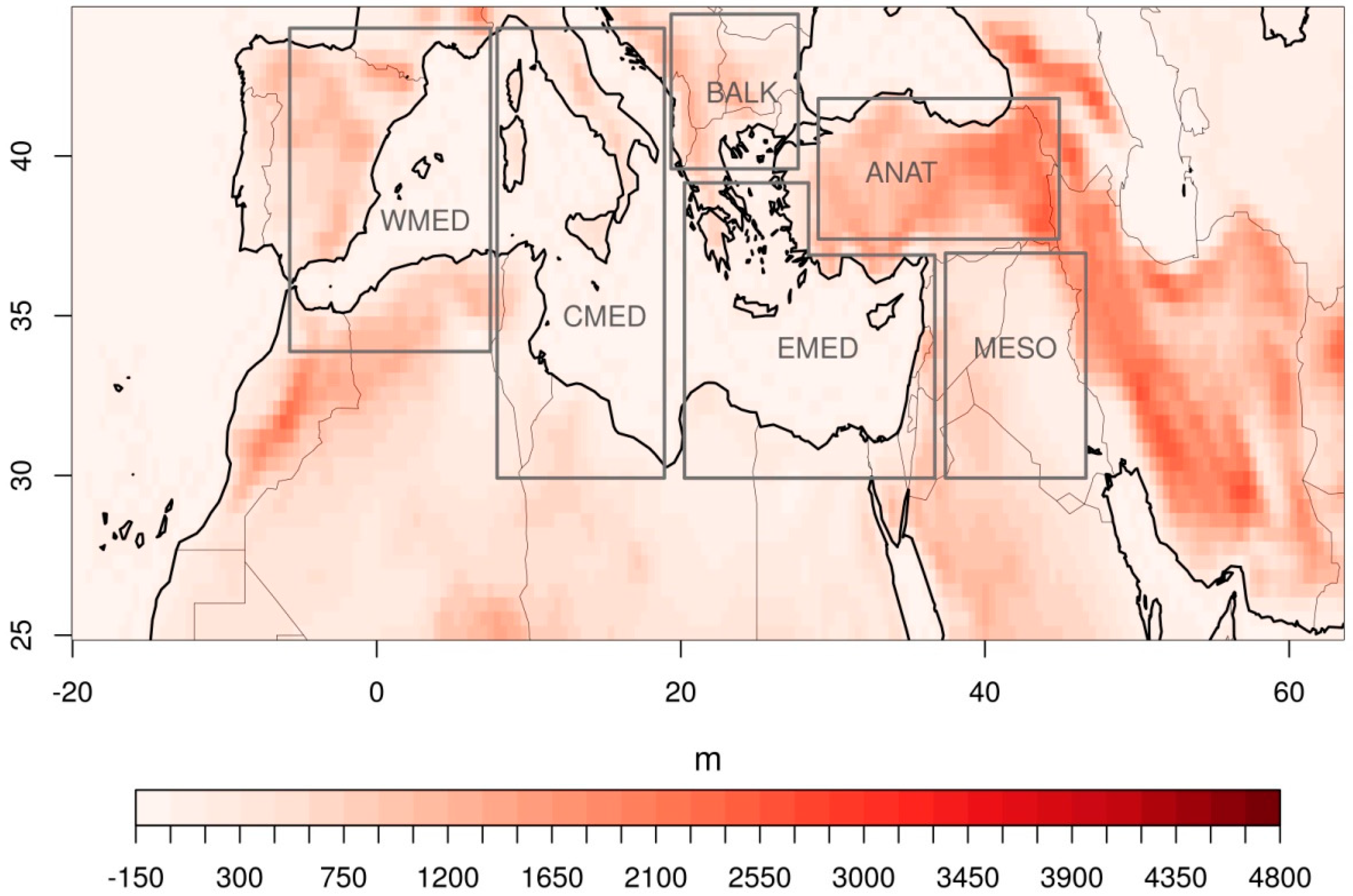
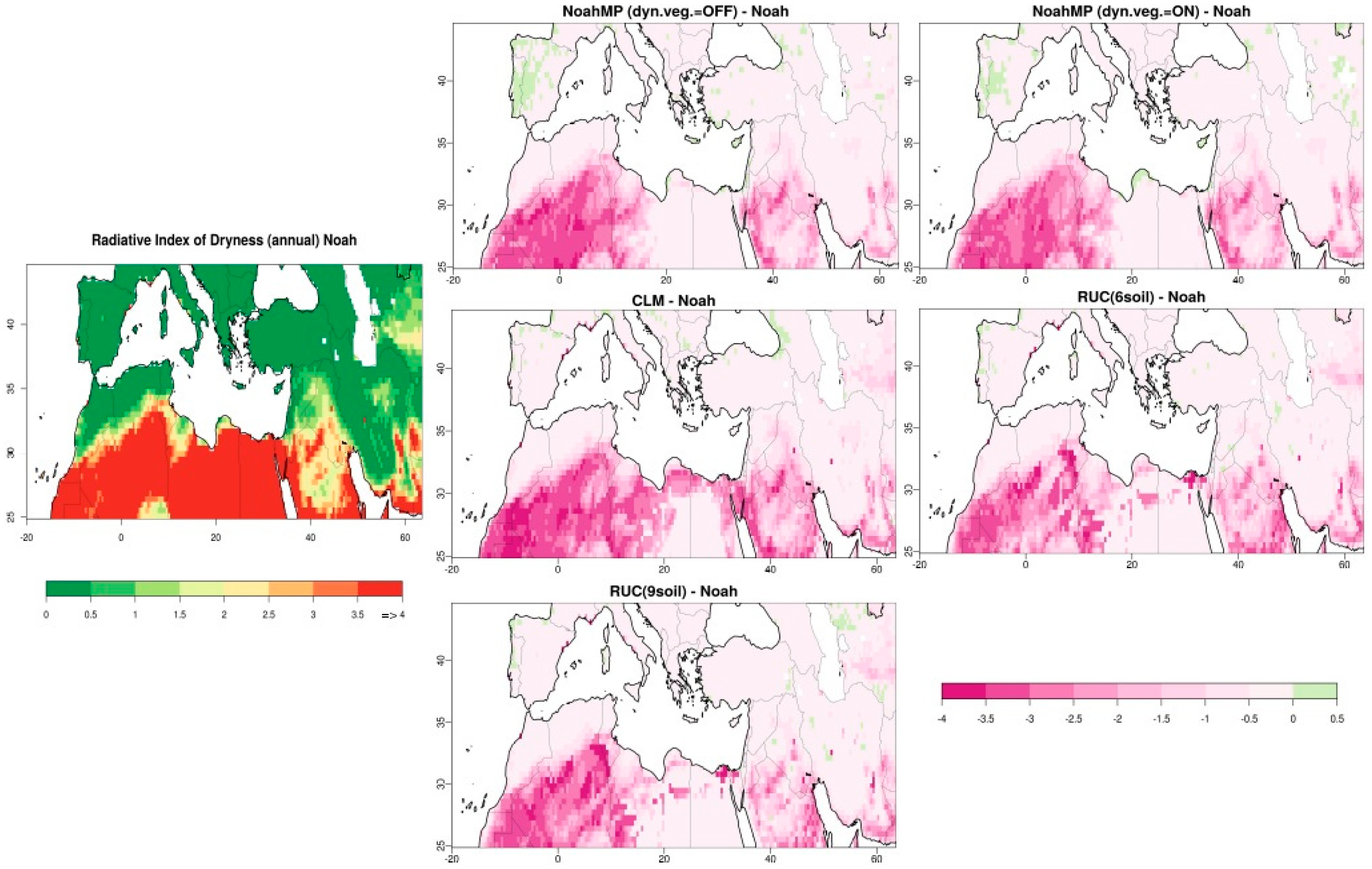
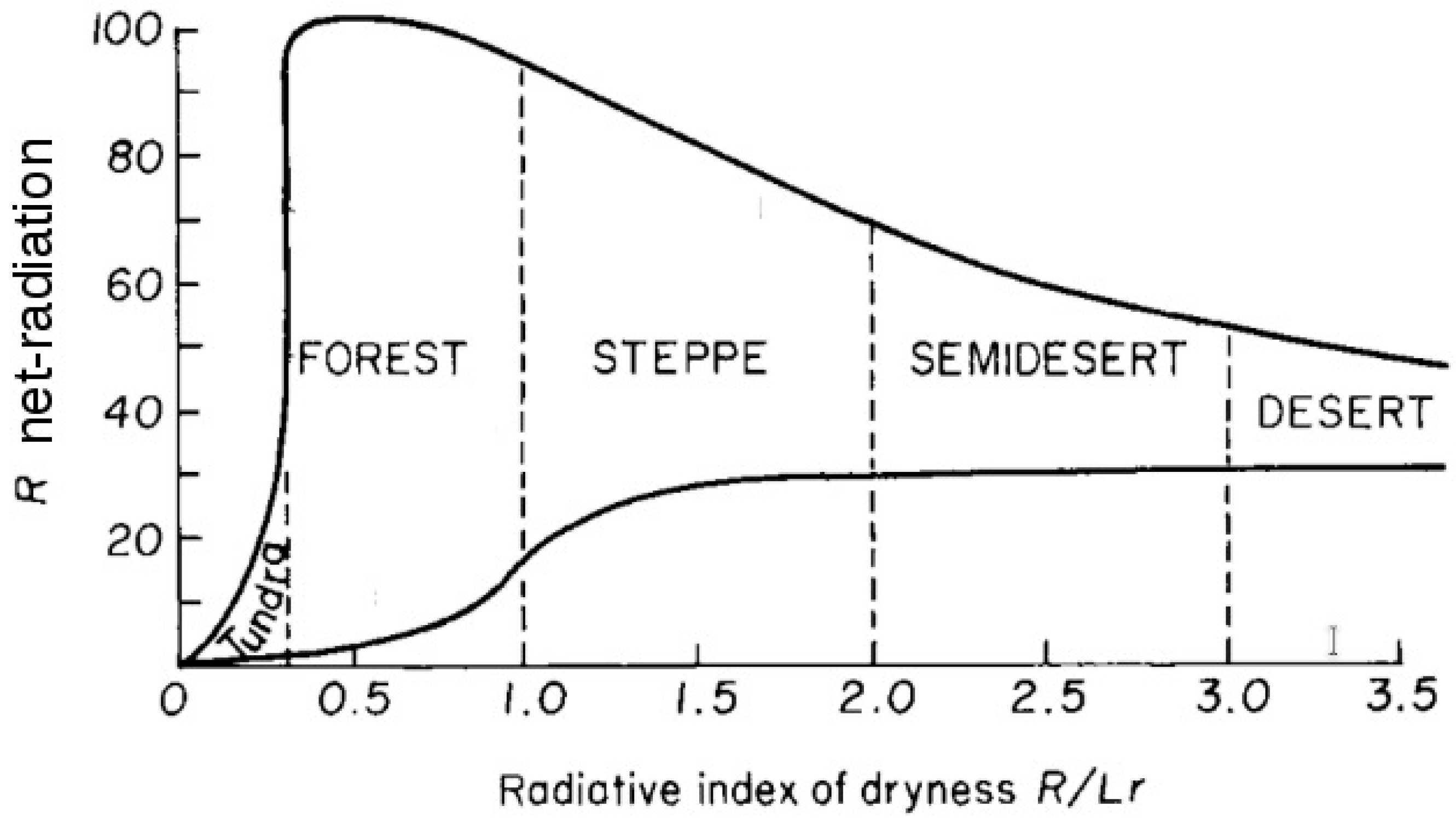
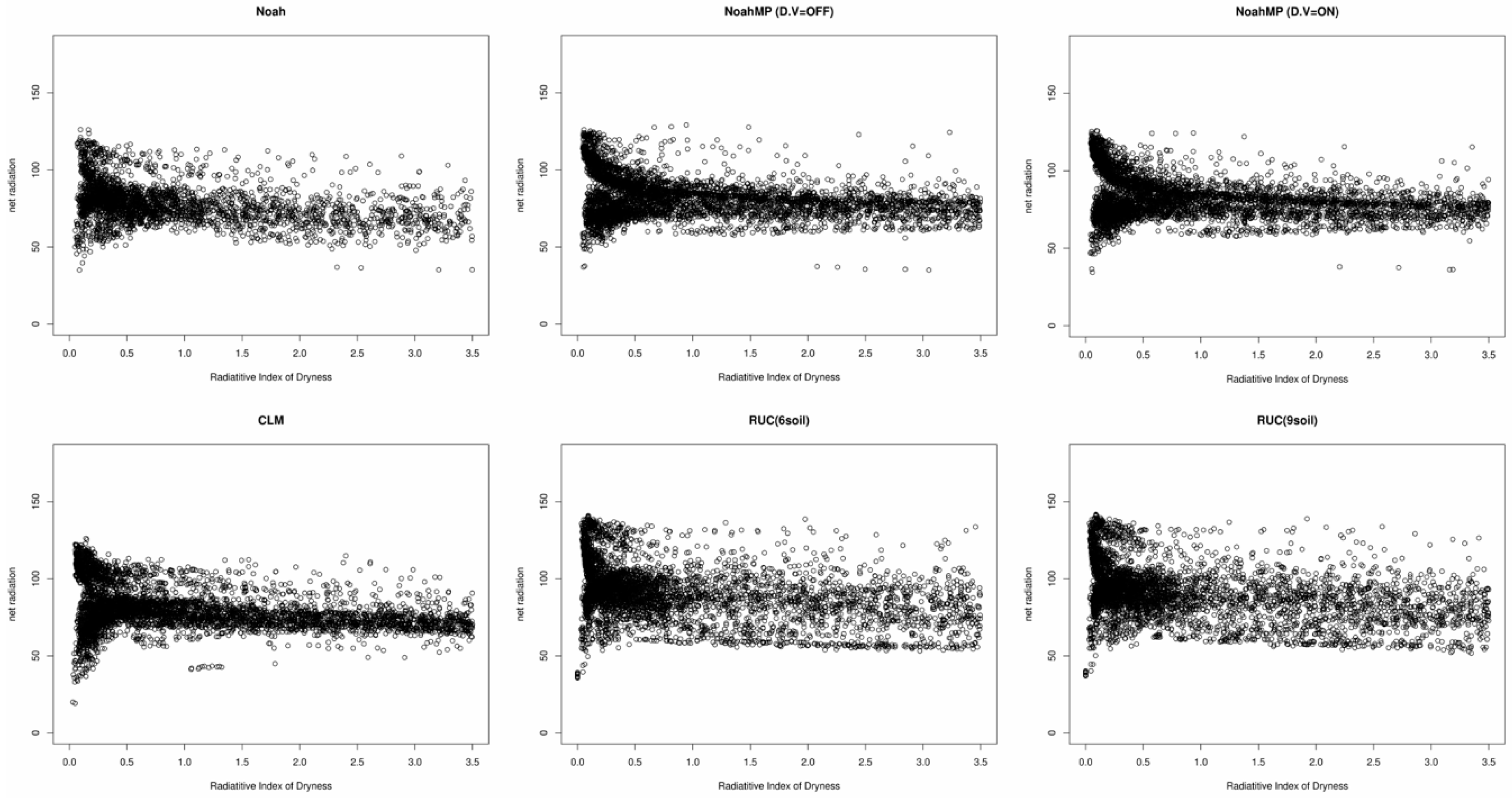
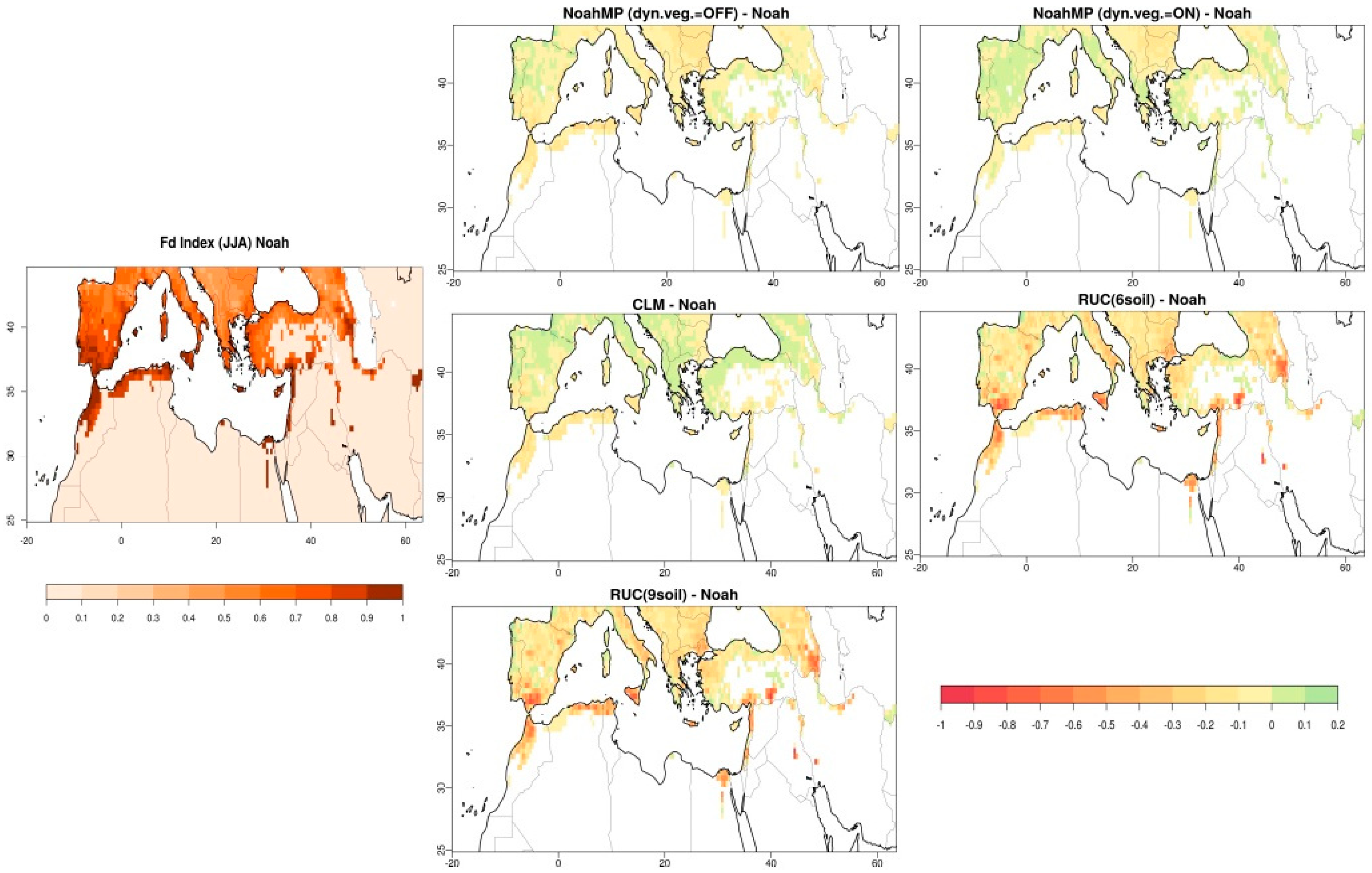
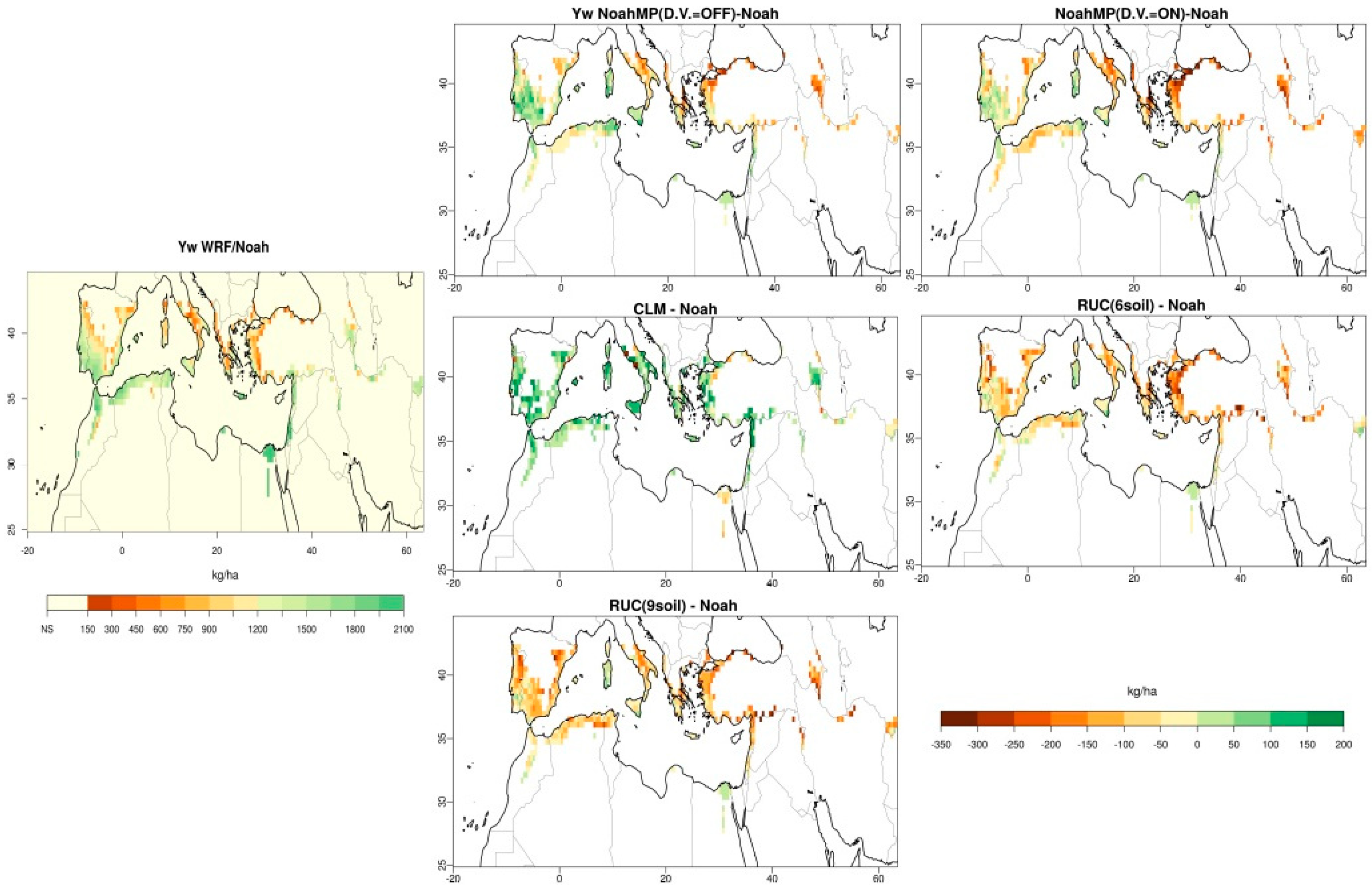
| Experiment No. | Land Surface Scheme | Number of Soil Layers |
|---|---|---|
| Run 1 | Noah | 4 |
| Run 2 | Noah-MP Dynamic vegetation = OFF | 4 |
| Run 3 | Noah-MP Dynamic vegetation = ON | 4 |
| Run 4 | CLM | 10 |
| Run 5 | RUC | 6 |
| Run 6 | RUC | 9 |
| RID | anat | balk | wmed | cmed | emed | meso | Whole Domain |
|---|---|---|---|---|---|---|---|
| Mean (r1:r6) | 0.301 | 0.176 | 5.846 | 11.473 | 27.379 | 8.212 | 3.511 |
| ΔNoah | 0.110 | 0.064 | −3.618 | 7.594 | 34.397 | 6.660 | 7.038 |
| ΔNoahMP (dyn.veg. = off) | 0.001 | 0.008 | 9.114 | 4.097 | 0.670 | −0.149 | −1.464 |
| ΔNoahMP (dyn.veg. = on) | −0.023 | −0.012 | 9.595 | 4.608 | 0.028 | −0.071 | −1.450 |
| ΔCLM | −0.052 | 0.004 | −5.120 | −6.715 | −19.813 | −4.905 | −2.529 |
| ΔRUC (6soil) | −0.015 | −0.031 | −4.945 | −4.626 | −7.700 | −1.216 | −0.978 |
| ΔRUC (9soil) | −0.022 | −0.034 | −5.027 | −4.959 | −7.581 | −0.318 | −0.616 |
| 2*σ | 0.114 | 0.072 | 14.536 | 12.224 | 36.801 | 7.484 | 3.507 |
| Rel. Disp. | 0.379 | 0.409 | 2.487 | 1.065 | 1.344 | 0.911 | 0.999 |
| Fd | anat | balk | wmed | cmed | emed | meso | Whole Domain |
|---|---|---|---|---|---|---|---|
| Mean (r1:r6) | 0.332 | 0.417 | 0.453 | 0.107 | 0.120 | 0.039 | 0.154 |
| ΔNoah | 0.023 | 0.101 | 0.053 | 0.023 | 0.017 | 0.006 | 0.018 |
| ΔNoahMP (dyn.veg. = off) | 0.015 | −0.028 | 0.015 | 0.004 | 0.011 | 0.004 | 0.005 |
| ΔNoahMP (dyn.veg. = on) | 0.019 | 0.006 | 0.048 | 0.015 | 0.015 | 0.007 | 0.014 |
| ΔCLM | 0.030 | 0.087 | 0.030 | 0.011 | 0.011 | 0.004 | 0.014 |
| ΔRUC (6soil) | −0.040 | −0.079 | −0.071 | −0.026 | −0.027 | −0.011 | −0.025 |
| ΔRUC (9soil) | −0.046 | −0.086 | −0.076 | −0.027 | −0.026 | −0.010 | −0.026 |
| 2*σ | 0.068 | 0.160 | 0.117 | 0.043 | 0.042 | 0.016 | 0.041 |
| Rel. Disp. | 0.205 | 0.384 | 0.258 | 0.402 | 0.350 | 0.406 | 0.265 |
| Yw | anat | balk | wmed | cmed | emed | meso | Whole Domain |
|---|---|---|---|---|---|---|---|
| Mean (r1:r6) | 701.225 | 737.064 | 803.143 | 354.810 | 487.295 | 60.329 | 241.175 |
| ΔNoah | 0.314 | 26.180 | 25.759 | 12.039 | 2.900 | −2.519 | 2.287 |
| ΔNoahMP (dyn.veg. = off) | 100.220 | 22.357 | 3.994 | −5.814 | 14.032 | 9.782 | 3.942 |
| ΔNoahMP (dyn.veg. = on) | 17.929 | −35.816 | 6.455 | −11.823 | 0.770 | 5.657 | −21.633 |
| ΔCLM | 33.076 | 88.141 | 91.379 | 36.844 | 17.946 | 5.119 | 26.918 |
| ΔRUC (6soil) | −171.354 | −127.924 | −72.245 | −8.818 | −23.278 | 1.734 | −4.329 |
| ΔRUC (9soil) | 19.814 | 27.062 | −55.341 | −22.429 | −12.370 | −19.773 | −7.186 |
| 2*σ | 181.581 | 147.875 | 117.824 | 42.491 | 31.277 | 21.056 | 22.056 |
| Rel. unc. | 0.259 | 0.201 | 0.147 | 0.120 | 0.064 | 0.349 | 0.091 |
© 2019 by the authors. Licensee MDPI, Basel, Switzerland. This article is an open access article distributed under the terms and conditions of the Creative Commons Attribution (CC BY) license (http://creativecommons.org/licenses/by/4.0/).
Share and Cite
Constantinidou, K.; Zittis, G.; Hadjinicolaou, P. Variations in the Simulation of Climate Change Impact Indices due to Different Land Surface Schemes over the Mediterranean, Middle East and Northern Africa. Atmosphere 2019, 10, 26. https://doi.org/10.3390/atmos10010026
Constantinidou K, Zittis G, Hadjinicolaou P. Variations in the Simulation of Climate Change Impact Indices due to Different Land Surface Schemes over the Mediterranean, Middle East and Northern Africa. Atmosphere. 2019; 10(1):26. https://doi.org/10.3390/atmos10010026
Chicago/Turabian StyleConstantinidou, Katiana, George Zittis, and Panos Hadjinicolaou. 2019. "Variations in the Simulation of Climate Change Impact Indices due to Different Land Surface Schemes over the Mediterranean, Middle East and Northern Africa" Atmosphere 10, no. 1: 26. https://doi.org/10.3390/atmos10010026
APA StyleConstantinidou, K., Zittis, G., & Hadjinicolaou, P. (2019). Variations in the Simulation of Climate Change Impact Indices due to Different Land Surface Schemes over the Mediterranean, Middle East and Northern Africa. Atmosphere, 10(1), 26. https://doi.org/10.3390/atmos10010026







